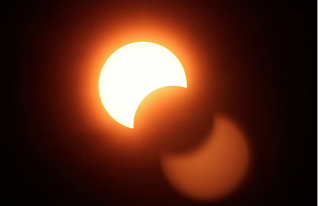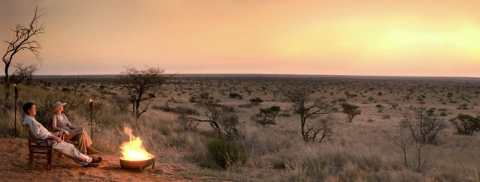SOLAR ECLIPSE IN NORTHERN
KENYA


A solar eclipse is always a rare and unique
event, but imagine seeing one from Northern
Kenya. This trip offers travelers the
chance to explore Kenya’s remote Northern
Frontier and take in a solar eclipse from
Sibiloi National Park on November 3rd, 2013.
This ultimate barefoot luxury adventure,
also includes 3 nights at Alex Walker’s
Serian Ngare Camp in the Masai Mara and 2
nights in the Lewa Conservancy at Lewa House
before heading by helicopter to Desert Rose
Lodge in the north to take in eclipse,
explore the area by camel and interact with
local tribes including the Samburu, Turkana
and El Molo. Join us for this one in a
lifetime experience!
Kenya's
New Western Tourism Circuit
Launched
 Most
travelers dream of finding a new and
unknown destination, somewhere far from
the beaten tourist path, where the
thrill of real discovery and
exploration reward the visitor with new
and unexpected experiences, sights and
sounds. While Kenya is known world wide
for its excellent Game Parks and
Reserves and idyllic tropical beaches,
there are large areas of the country
that remain largely unknown and seldom
visited. Kenya is now encouraging
visitors to explore and experience
these hidden treasures.
Most
travelers dream of finding a new and
unknown destination, somewhere far from
the beaten tourist path, where the
thrill of real discovery and
exploration reward the visitor with new
and unexpected experiences, sights and
sounds. While Kenya is known world wide
for its excellent Game Parks and
Reserves and idyllic tropical beaches,
there are large areas of the country
that remain largely unknown and seldom
visited. Kenya is now encouraging
visitors to explore and experience
these hidden treasures.
The
West of Kenya is an area of great
geographic, cultural and natural
diversity, offering tourists just as
much, if not more, than many of Kenya's
better known tourist areas. Plans are
underway to work with communities
throughout the West to publicize and
develop the many attractions that the
region has to offer.
Kenya
is keeping pace with the demands of the
international tourism market, and
offering a diversified range of
destinations beyond simply wildlife and
beach safaris. At the small village of
Si Galla Galla, near Kakamega, one can
catch a spectacular traditional
bullfight. Such events are an important
event for the local Luhya community.
Held throughout the year, these are
pitched battles between two bulls each
one representing an individual village.
Thronged by excited supporters, the
bulls lock horns and fight until one
bull turns and runs. The winning bull
is led around the field in a victory
lap, accompanied by a chanting,
jubilant crowd.
This
impressive spectacle represents a
significant cultural link between
traditional African cattle culture and
the art of bullfighting as practiced
throughout Southern Europe.
The
Kakamega forest reserve is also on the
western circuit. Local guides told us
Kakamega is a remnant forest, once
linked to the great Equatorial forests
of the Congo, and is home to a number
of unique and endangered species. The
forest has resident populations of
primates, including the rare red tailed
monkey, butterflies, chameleons and
stunning birdlife, such as the giant
Blue Turaco.
In
order to promote local conservation,
KEEP (Kakamega Environmental Education
Program) has been established, which is
a community group working with local
children to ensure that the forest and
its resources are protected and
preserved for the future. They also
provide guiding services to local
guesthouses and have constructed
accommodation facilities for
backpackers within the grounds of the
forest station.
Another
tourist attraction is Kit Mikaye, in
Seme. Despite its close proximity to
Kisumu, very few people visit this
sacred site. Set among a field of
boulders, Kit Mikaye is a large upright
stone, bolstered by smaller supporting
boulders. Myths and legends regarding
the stone abound among the local Luo
community. It was once believed to be a
living entity that roamed this area at
night, visiting nearby Lake Victoria to
drink. Sacrifices were made to the
stone in return for divine favor and
blessings. Even today, some believe
that a visit to Kit Mikaye bestows good
fortune upon the visitor.
 The
local community is now offering guided
tours through the passages within the
rock, which are also home to large
colonies of bats and nesting
birds.
The
local community is now offering guided
tours through the passages within the
rock, which are also home to large
colonies of bats and nesting
birds.
One
can attend a special commemorative boat
race between local fishermen in
traditional Ssese canoes.
A
real highlight is a sunset trip to
Mbasa and Mholo Islands, not far from
Mbita Point. These two islands form a
very important breeding colony for =day
is an incredible experience. Thousands
of birds fill the air, literally
carpeting both islands in life as they
descend to roost among the rocks and
trees. With the last rays of the sun
turning the waters of the Lake to gold,
this is one of Kenya's greatest natural
spectacles.
Close
by is Ruma National Park. This little
visited park comprises 120 square kms
of savannah and gently rolling hills.
This is the last refuge of the very
Roan antelope, with the world's last
remaining wild population found within
the boundaries of the park. The Roan
are easy to see on the wide open
grasslands, grazing freely among stands
of whistling thorn acacia. Ruma is also
home to several other rare species,
chiefly the Rothschild Giraffe,
Jackson's Hartebeest and the tiny Oribi
antelope.
From
the heat of Ruma, one can move on to
the relative cool of the beautiful
Western Highlands. Tabaka near Kisii in
the Western Highlands, is home to
Kenya's finest stone carvers. The Kisii
/ Gusii community are renowned for
their artistic skill with the local
soapstone. They have a long tradition
of carving ornate decorative art and
jewelry, together with functional items
such as plates and bowls.
The
stone is found in a series of large
open quarries throughout the Gucha
area, which have also proved equally
rich in uncovered fossil evidence and
prehistoric artifacts. Cooperative
workshops have been formed to produce
work for the international market.
Kisii stone is sold worldwide, and
several works by Tabaka artists have
found a place in major international
art collections. Tabaka soapstone
graces the UN HQ in New York, and the
UNESCO HQ in Paris, in the form of a
massive 7- ton "bird of peace" or
Enyamuchera.
The
success of this industry shows in the
town of Tabaka, where every household
seems to be busily engaged in carving,
polishing, washing and packaging
stoneware. This very success has meant
the preservation of a very important
cultural tradition. A visit here is an
excellent opportunity to experience
this rich culture and to purchase some
beautiful handcrafted works of
art.
Also
in the Western Highlands is Kericho.
This small town was brought to life by
the Kenyan tea industry. The lush green
carpet of tea bushes that cover these
high cool hills are quite literally
fields of gold. Tea remains Kenya's
highest foreign exchange earner, and
this region produces one of the world's
finest quality teas.
Agri-tourism
is becoming increasingly popular, and
the small colonial hill town of Kericho
is the perfect base to visit the local
plantations, producing both tea and
fresh cut flowers. Tea plantations also
play an important role in local
ecology, and are used a buffer zone to
protect tracts of indigenous
forest.
Moving
North to Eldoret, this area holds great
untapped potential for tourist
development. From the heights of Mt
Elgon on the Ugandan Border to the arid
savannah around Lake Baringo, this
region offers a great diversity of
attractions.
Sports
tourism is becoming increasingly
popular around the world, and Kenya's
Western Highlands are the home to some
of the world's finest sportsmen. In the
days preceding the Western Kenya
launch, Kenyan runners had dominated
the international athletic scene,
taking 1st, 2nd, 3rd, 4th, 6th and 7th
place for men and 1st and 2nd for women
in the Boston Marathon.
The
secret of this success lies in these
hills. The average altitude in this
area is well over 2000m, and these
rarified conditions are ideal training
conditions for runners. Two local
schools, St. Patrick's at Iten and
Sing'ore Girls near Eldoret have
produced most of Kenya's Olympic
Superstars. Altitude training can
assist with development of both
endurance levels and technique. Five
separate highly specialized training
camps for athletes have been
established in the Iten and Kabarnet
area, for both local and International
athletes. These are ideal for athletes
looking to gain a high altitude
advantage.
Finally,
not to be missed are the Tugen Hills at
Kipsaraman, where one of Kenya's first
community museums has been opened. The
museum houses exhibits on biodiversity
and conservation, as well as important
local human fossil finds and a
fascinating exhibit on the possible
prehistoric origins of a local
mythological creature, the Chemosit, or
Nandi Bear.
Even
more impressive than the museum itself
is its location. Perched on a the edge
of a precipitous drop, the view from
Kipsaraman is an incredible panoramic
vista of the Rift valley and distant
Lake Baringo that quite literally takes
the breath away.
Kenya
invites visitors to come and experience
the wild, wonderful and welcoming
West.
 .
. .
.
 .
. .
.